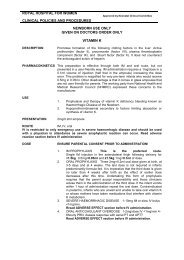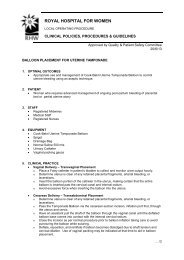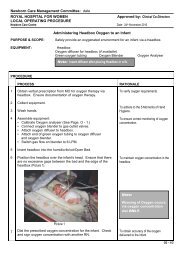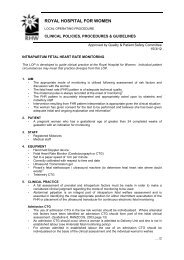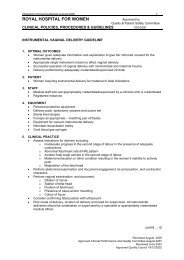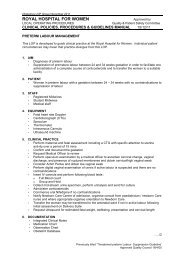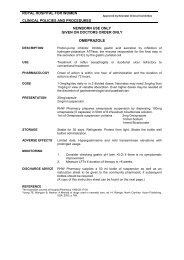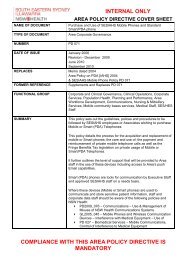NicoletOne
NicoletOne
NicoletOne
You also want an ePaper? Increase the reach of your titles
YUMPU automatically turns print PDFs into web optimized ePapers that Google loves.
Newborn Care Management Committee 10/8/11 1.<br />
ROYAL HOSPITAL FOR WOMEN Approved by<br />
LOCAL OPERATING PROCEDURES Quality & Patient Safety Committee<br />
CLINICAL POLICIES, PROCEDURES & GUIDELINES MANUAL 18/8/11<br />
NICOLETONE (aEEG ) BRAIN MONITOR APPLICATION<br />
This LOP is developed to guide clinical practice at the Royal Hospital for Women. Individual patient<br />
circumstances may meant that practice diverges from this LOP.<br />
PURPOSE & SCOPE: To apply the Viasys <strong>NicoletOne</strong> aEEG monitor to the newborn for<br />
brain monitoring.<br />
The following babies may be considered for aEEG monitoring:<br />
• Any baby who is receiving whole body hypothermia<br />
(cooling) as per the RHW NCC Moderate Whole Body<br />
Hypothermia Protocol for Moderate to Severe Neonatal<br />
Hypoxic-Ischaemic Encephalopathy (HIE) in infants ≥ 35<br />
weeks gestation<br />
• Any baby with abnormal movements or severe apnoeas<br />
that raise the suspicion of seizure activity<br />
• Any baby with a suspected encephalopathy such as<br />
markedly abnormal tone or responsiveness<br />
• A muscle-relaxed (paralysed) baby (ie: on Pancuronium<br />
or Rocuronium) who is at risk of HIE or neurologic<br />
abnormality<br />
• Any baby with a probable significant hypoxic/ischaemic<br />
event around birth<br />
EQUIPMENT: <strong>NicoletOne</strong> machine and cables<br />
6 EEG electrodes (gold)<br />
Packet of Gauze<br />
Sensor-positioning aid (Brainz brand) or tape measure<br />
NUPREP Abrasive Gel<br />
Conductive EEG paste (EC2)<br />
“Mefix” Tape / “Surgifix” Tubular stretch bandage<br />
Sucrose and 1mL syringe for dispensing<br />
Micropore<br />
Crepe Bandage<br />
Note: All the above stored in EEG Transport Box on the <strong>NicoletOne</strong><br />
PROCEDURE<br />
1<br />
2<br />
PROCESS<br />
Obtain verbal consent from parents.<br />
Administer sucrose to the infant prior to commencement of<br />
the procedure.<br />
RATIONALE<br />
To inform and reassure parents of the<br />
procedure.<br />
To provide pain/discomfort relief to the<br />
infant.<br />
…./2
Newborn Care Management Committee 10/8/11 2.<br />
ROYAL HOSPITAL FOR WOMEN Approved by<br />
LOCAL OPERATING PROCEDURES Quality & Patient Safety Committee<br />
CLINICAL POLICIES, PROCEDURES & GUIDELINES MANUAL 18/8/11<br />
NICOLETONE (aEEG ) BRAIN MONITOR APPLICATION cont’d<br />
PROCEDURE<br />
3<br />
4<br />
5<br />
6<br />
7<br />
8<br />
9<br />
10.<br />
11.<br />
13.<br />
PROCESS<br />
Starting the <strong>NicoletOne</strong> monitor<br />
Plug electrical cord into mains power.<br />
Check:<br />
• 3 connections on right edge of screen are secure<br />
before switching on.<br />
• Amplifier Headbox is plugged into cable<br />
connected to screen.<br />
Switch machine on (Switch is located at the bottom of screen<br />
next to power cord entry).<br />
Click OK on Log On Box (No password is required).<br />
Double-click on NicVue Icon. (Patient database should now be<br />
on the screen.)<br />
Click NEW (located at the upper Left corner of screen.)<br />
Enter patient details for new patient:<br />
• For DOB ⇒ use DD/MM/YYYY<br />
• Click Nicolet icon (centre of screen display of<br />
Montage selections)<br />
• Select “RHW aEEG protocol” (in protocol box<br />
(F3, F4, P3, P4) – Even is on Right,<br />
Odd is on Left.<br />
• Impedance value is set at
Newborn Care Management Committee 10/8/11 3.<br />
ROYAL HOSPITAL FOR WOMEN Approved by<br />
LOCAL OPERATING PROCEDURES Quality & Patient Safety Committee<br />
CLINICAL POLICIES, PROCEDURES & GUIDELINES MANUAL 18/8/11<br />
NICOLETONE (aEEG ) BRAIN MONITOR APPLICATION cont’d<br />
PROCEDURE<br />
14.<br />
15<br />
16<br />
17<br />
18<br />
19<br />
PROCESS<br />
Attaching EEG leads:<br />
Feed all 6 electrode cables through 10cm length of Surgifix<br />
tubular bandage.<br />
Surface Electrode Application<br />
15.1 Part hair at sites that have been measured.<br />
15.2 Rub sites with Nuprep Abrasive gel using 3 cotton<br />
wool buds from the pack.<br />
15.3 Wipe edges of prepped area of excess cream.<br />
15.4 Put a blob of EC2 paste onto the electrode<br />
underside.<br />
15.5 Apply Mefix square on top of gold Surface<br />
Electrode and apply to cleaned/abraided surface.<br />
15.6 Plug electrode cables into Reference and ground<br />
sockets on <strong>NicoletOne</strong> Amplifier box.<br />
Apply the other 4 gold electrodes in the locations as set out<br />
in Step 14 - 17, with leads pointing up towards the vertex of<br />
the head.<br />
Plug the 6 electrode cables into the sockets on <strong>NicoletOne</strong><br />
Amplifier box in the following locations:<br />
LHS Frontal into F3 LHS Parietal into P3.<br />
RHS Frontal into F4, RHS Parietal into P4.<br />
Forehead into Ground Occipital into Reference<br />
Click on Impedance icon on Toolbar (Top left of monitor<br />
screen). Check impedance is 10: Repeat procedure from step 16 and reapply the electrode.<br />
…./4
Newborn Care Management Committee 10/8/11 4.<br />
ROYAL HOSPITAL FOR WOMEN Approved by<br />
LOCAL OPERATING PROCEDURES Quality & Patient Safety Committee<br />
CLINICAL POLICIES, PROCEDURES & GUIDELINES MANUAL 18/8/11<br />
NICOLETONE (aEEG ) BRAIN MONITOR APPLICATION cont’d<br />
PROCEDURE<br />
20<br />
21<br />
22<br />
23<br />
PROCESS<br />
Slide Surgifix over infant’s head to support electrode fixation<br />
(Picture 3)<br />
To Re-Check the Contact Impedance (See Step 17):<br />
• Each of the 6 lights indicates one of the 6 electrodes<br />
in the scalp.<br />
• All 6 lights should be green.<br />
• If impedance colour is Red (impedance >10kΩ)<br />
o Repeat procedure from Step 15 and reapply<br />
the electrodes.<br />
o If all lights are Red check Ref and Neutral<br />
fixation (See Picture 4).<br />
o If all lights are green commence monitoring –<br />
Step 22 (See Picture 4).<br />
To Commence Monitoring<br />
Click Start button on screen below connection layout.<br />
Select “Notch” in Toolbar on top of screen. (This will filter<br />
unwanted noise from signal).<br />
NOTE: Event boxes (RHS of lower EEG<br />
trace) can be selected to add event<br />
markers to recording.<br />
RATIONALE<br />
Picture 4<br />
Picture 5<br />
To activate monitoring on screen and start<br />
recording.<br />
…./5
Newborn Care Management Committee 10/8/11 5.<br />
ROYAL HOSPITAL FOR WOMEN Approved by<br />
LOCAL OPERATING PROCEDURES Quality & Patient Safety Committee<br />
CLINICAL POLICIES, PROCEDURES & GUIDELINES MANUAL 18/8/11<br />
NICOLETONE (aEEG ) BRAIN MONITOR APPLICATION cont’d<br />
PROCEDURE<br />
24<br />
25<br />
26<br />
PROCESS<br />
To Ensure Accurate Recording<br />
If electrodes disconnect or impedance becomes >10kΩ<br />
24.1 a Bad Electrode Event Alert Box will appear on the<br />
monitor impedance screen.<br />
24.2 click OK and then select Impedance box on top of<br />
Toolbar of screen to check electrode indicators.<br />
24.3 follow instructions (see above) to improve contact if<br />
impedance for any lead is >10kΩ.<br />
24.4 click START box to recommence recording.<br />
24.5 Decrease electrical interference if possible.<br />
Turn off non-essential equipment (such as Radios<br />
and Mobile Phones) where possible.<br />
To Shut Down<br />
25.1 Select “File” on top Left of Acquisition Screen and<br />
click on “Exit”.<br />
25.2 Select “OK” to “Do you want to close the ongoing<br />
test”.<br />
25.3 Select “File” on top Left of Database Screen and click<br />
on “Exit”.<br />
25.4 Select “Start” at bottom Left of screen then select<br />
“Shutdown” in menu box.<br />
NOTE:<br />
DO NOT remove power until Windows message on<br />
screen says it is safe to do so<br />
Removal of electrodes<br />
• Remove Mefix tapes.<br />
• Wipe electrode sites with gauze and warm water<br />
• Remove electrodes.<br />
• Do not discard electrodes.<br />
RATIONALE<br />
Electrically radiating equipment may cause<br />
interference to an EEG reading.<br />
To enable easy removal of electrodes.<br />
The electrodes are re-usable.<br />
…./6
Newborn Care Management Committee 10/8/11 6.<br />
ROYAL HOSPITAL FOR WOMEN Approved by<br />
LOCAL OPERATING PROCEDURES Quality & Patient Safety Committee<br />
CLINICAL POLICIES, PROCEDURES & GUIDELINES MANUAL 18/8/11<br />
NICOLETONE (aEEG ) BRAIN MONITOR APPLICATION cont’d<br />
PROCEDURE<br />
27<br />
28<br />
PROCESS<br />
Documentation<br />
• Document observation chart the time aEEG is<br />
commenced on the infant<br />
• Record all seizure activity on Seizure Chart.<br />
• Mark all events on the patient recording using menu<br />
buttons on bottom Right of screen<br />
e.g. possible seizure, administration of anticonvulsant<br />
drugs, IV procedure, suctioning etc.<br />
Notify medical staff of any abnormal rhythmic activity that is<br />
recorded on the monitor.<br />
References<br />
RATIONALE<br />
RHW NCC Moderate Whole Body Hypothermia Protocol for Neonatal Hypoxic-Ischaemic<br />
Encephalopathy (HIE) in infants ≥ 35 weeks gestation, November 2007.<br />
The BRAINZ BRM2 Monitor: Its Application and Use in an Infant Patient, 2005.





